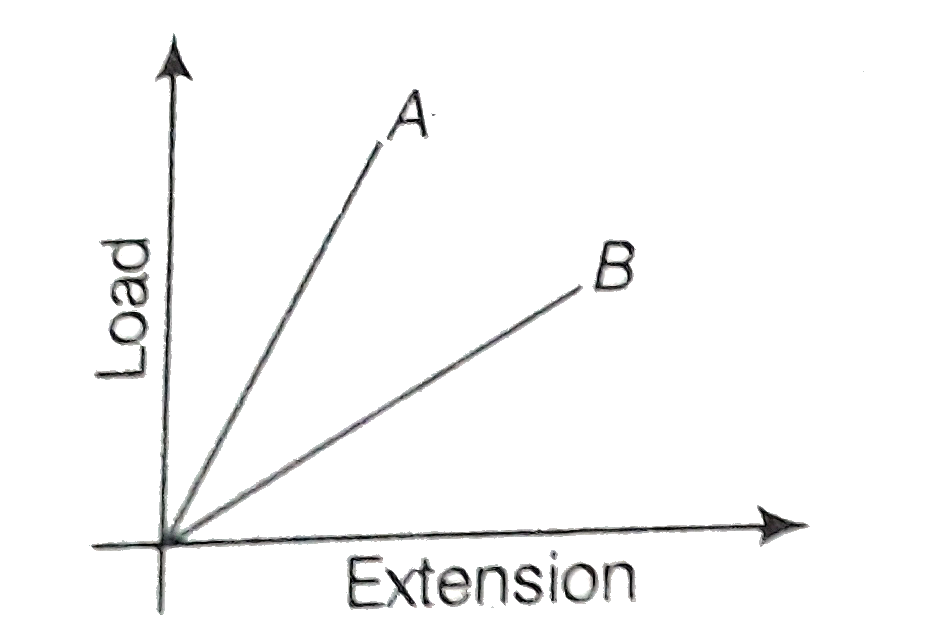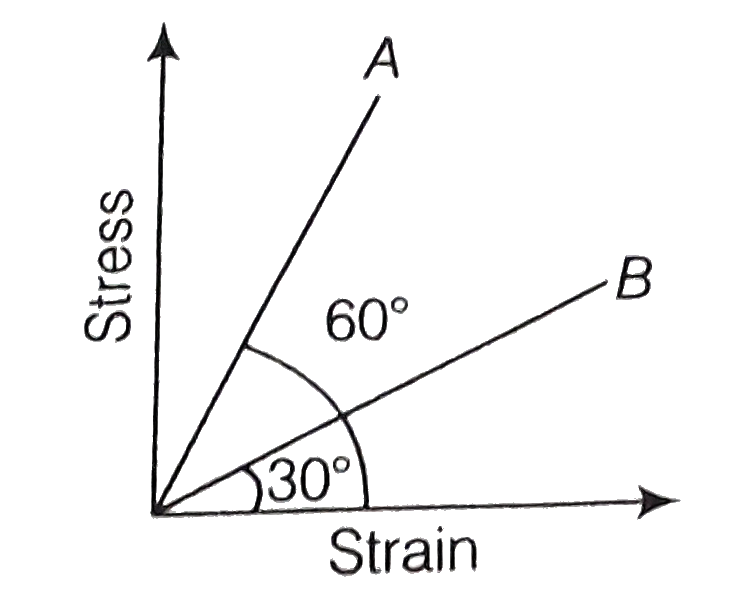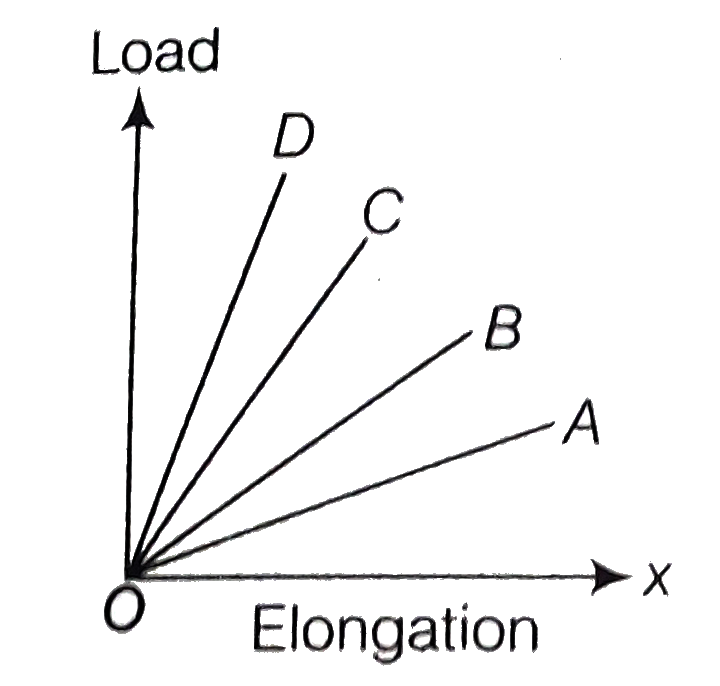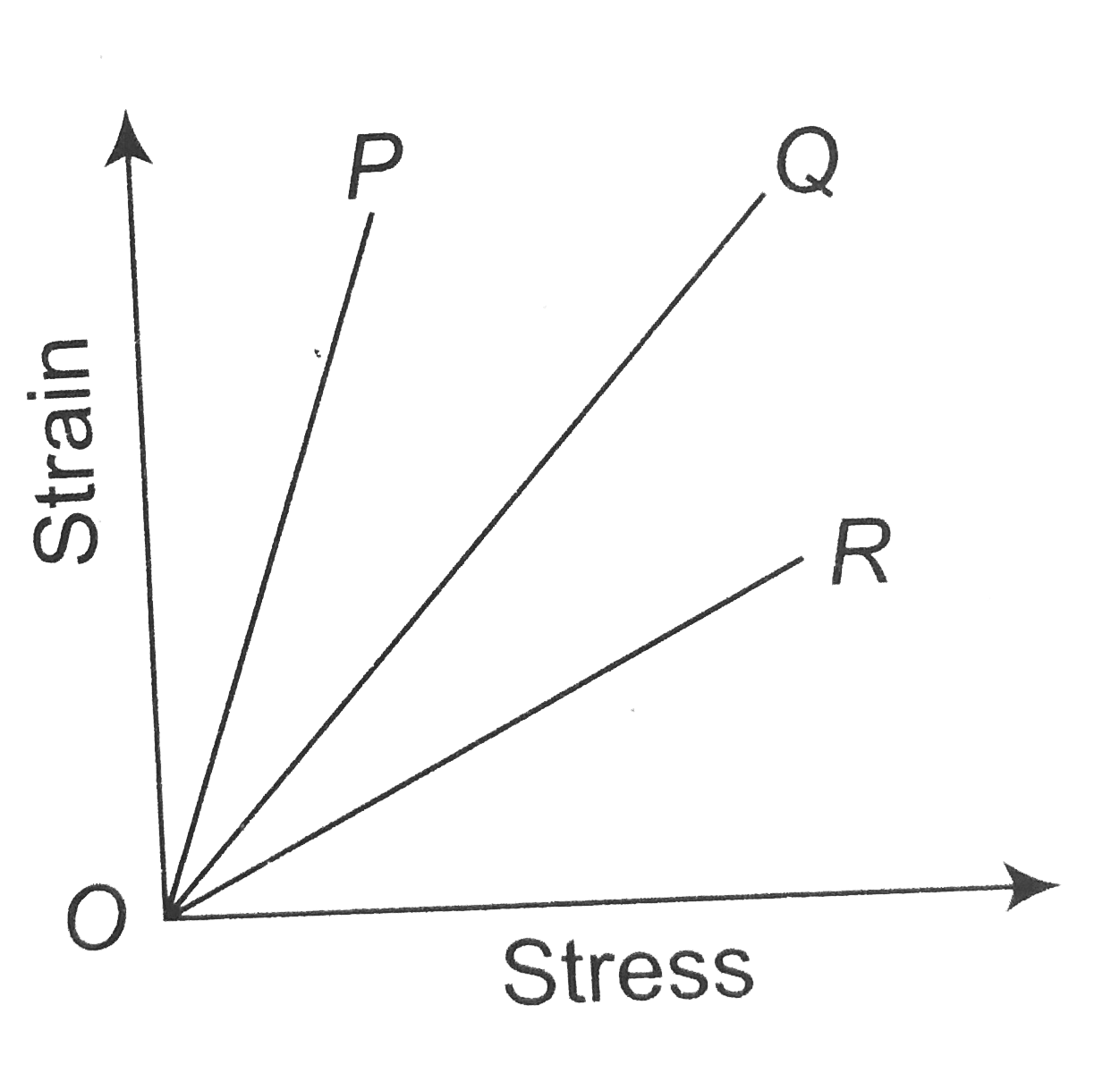Complete Solutions to EXERCISE 2 of chapter ELASTICITY of Class 12 book with complete answers and questions
| Class 12 | PHYSICS |
| Chapter | ELASTICITY |
| MHTCET PREP GUIDE | EXERCISE 2 |
| Number Of Questions | 48 |
| Academic Year | 2023-24 |
In the given figure, if the diamensions of the wires are the same and materials are different, Young's modulus is more for

View SolutionAn elastic material with Young's modulus Y is subjected to a tensile stress S, elastic energy stroed per unit volume of the material is
View SolutionThe bulk modulus of water is `2.1xx10^(9) Nm^(-2)`. The pressure required ot increase the density of water by 0.1% is
View SolutionA thick rope of rubber of density `1.5 xx 10^(3) kg m^(-3)` and Young's modulus `5 xx 10^(6) Nm^(-2)`, 8 m in length, when hung from ceiling of a room, the increases in length due to its own weight is
View SolutionA brass rod of length 2 m and corss-sectinal area `2.0 cm^(2)` is attached to end to a steel rod of length L and corss-sectinal area `1.0 cm^(2)`. The compound rod is subjected to equal and opposite pulls of magnitude `5 xx 10^(4) N` at its ends.
If the elongations of the two rods are equal, then the length of the steel rod L is `(Y_("brass") = 1.0 xx 10^(11) Nm^(-2)` and `y_("steel") = 2.0 xx 10^(11) Nm^(-2))`
View SolutionAn elevator cable is to have a maximum stress of `7 xx 10^(7) Nm^(-2)` to allow for appropriate safety factors. Its maximum upward acceleration is `1.5 ms^(-2)`. If the cable has to support the total weight of 2000 kg of a loaded elevator, the area cross-section of the cable should be
View SolutionA uniform steel bar of cross-sectional area A and length L is suspended, so that it hangs vertically. The stress at the middle point of the bar is (`rho` is the density of stell)
View SolutionMatch the following column I and column II.
`{:("Column I","Column II"),(A. "Stress" xx "strain", 1. j),(B. YA//I,2. N//m),(C.Yl^(3),3.J//m^(3)),(D.Fl//AY,4.m):}`
View SolutionA solid block of silver with density `10.5 xx 10^(3) kg m^(-3)` is subjected to an external pressure of `10^(7) Nm^(-2)`. If the bulk modulus of silver is `17 xx 10^(10) Nm^(-2)`. Then the change in density of silver (in `kg m^(-3)`) is
View SolutionA stress of `1kg//mm^(2)` is applied on a wire. If the modulus of elasticity of the wire is `10^(10) "dyne"//cm^(2)`, then the percentage increase in the length of the wire will be
View SolutionA rectangular bar 2 cm in breadth, 1cm in depth and 100 cm in length is supported at its ends and a load of 2kg is applied at its middle. If young's modulus of the material of the bar is `20 xx 10^(11)` `"dyne"` / `cm^(-2)`, the depression in the bar is
View SolutionA steel wire of length 20 cm and uniform cross-sectional `1 mm^(2)` is tied rigidly at both the ends. The temperature of the wire is altered from `40^(@)C` to `20^(@)C`. Coefficient of linear expansion of steel is `alpha = 1.1 xx 10^(-5) .^(@)C^(-1)` and Y for steel is `2.0 xx 10^(11) Nm^(2)`, the tension in the wire is
View SolutionA copper wire `(Y=10^(11) Nm^(-2))` of length 8 m and a steel wire `(Y=2xx10^(11) Nm^(-2))` of length 4 m, each of `0.5 cm^(2)` cross-section are fastened end to end and stretched with a tension of 500 N. choose the correct option.
View SolutionA stress of `10^(6) Nm^(-2)` is required for breaking a material. If the density of the material is `3 xx 10^(3) kg m^(-3)`., then what should be the length of the wire made of this material, so that it breakes under its own weight?
View SolutionThe temperature of a wire length 1 m and area of cross-section `1 cm^(2)` is increased from `0^(@)C` to `100^(@)C`. If the rod is not allowed to increase in length, then the force, required will be `(alpha = 10^(-5) ""^(@)C^(-1)` and `Y = 10^(11) Nm^(-2)`)
View SolutionTwo wires of copper having the length in the ratio `4 : 1` and their radii ratio as `1 : 4` are stretched by the same force. The ratio of longitudinal strain in the two will be
View SolutionA steel wire of length 20 cm and uniform cross-sectional area of `1 mm^(2)` is tied rigidly at both the ends at `45^(@)C`. If the temperature of the wire is decreased to `20^(@)C`, then the change in the tension of the wire will be
[Y for steel `= 2 xx 10^(11 Nm^(-2)`, the coefficient of linear expansion for steel `= 1.1 xx 10^(-5)//""^(@)CC^(-1)`]
View SolutionA force of 20 N is applied at one end of a wire of length 2 m having area of cross-section `10^(-2) cm^(2)`. The other end of the wire is rigidly fixed. If coefficient of linear ezpanison of the wire `alpha = 8 xx 10^(-6) .^(@)C^(-1)` and Young's modulus `Y = 22 xx 10^(11) Nm^(-2)` and its temperature is increased by `5^(@)C`, then the increase in the tension of the wire will be
View SolutionTwo wires of same diameter of the same material having the length `l` and `2l` If the force `F` is applied on each, the ratio of the work done in two wires will be
View SolutionA 5 metre long wire is fixed to the ceiling. A weight of 10 kg is hung at the lower end at is 1 metre above the floor. The wire was alongated by 1 mm. The energy stored in the wire due to stretching is
View SolutionThe stress versus strain graphs for wires of two materials A and B are as shown in the figure. If `Y_(A)` and `Y_(B)` are the young's modulii of the materials, then

View SolutionThe load versus elongation graph for four wire of the same material is shown in the figure. The thickest wire is represented by the line

View Solution
The strain stress curves of three wires of different materials are shown in the figure. P, Q and R are the elastic limits of the wires. The figure shown that
View SolutionThe density of a metal at normal pressure is `rho`. Its density when it is subjected to an excess pressure p is `rho'` . If B is the bluk modulus of the metal, then find the ratio `rho'//rho`.
View SolutionThe poisson's ratio of a material is 0.1. If the longitudinal strain of a rod of this material is `10^(-3)`, then the percentage change in the volume of the rod will be
View SolutionThe poisson's ratio of a material is 0.4. if a force is applied to a wire of this material, there is a decrease of cross-sectional are a by 2%. The percentage increases in its length is
View SolutionThe symbols, Y,K and `eta` represent the Young's modulus, bulk modulus and rigidty modulus of the material of a body. If `eta = 3 K`, then
View SolutionA solid sphere of radius R made of a material of bulk modulus K is surrounded by a liquid in a cylindrical container. A massless pistion of area A floats on the surface of the liquid. When a mass M is placed on the piston to compress the liquid the fractional change in the radius of the sphere, `deltaR//R`, is .............
View SolutionThe bulk modulus of a metal is `8 xx 10^(9) Nm^(-2)` and its density is 11 g `cm^(-2)`. The density of this metal under a pressure of 20000 N `cm^(-2)` will be (in g `cm^(-3)`)
View SolutionWhen a force is applied on a wire of uniform cross-sectional are `3 xx 10^(-6) m^(2)` and length 4 m, the increase in length is 1 mm. Energy stored in it will be (Given, `Y = 2 xx 10^(11) Nm^(-2)`)
View SolutionA wire of cross section `A` is stretched horizontally between two clamps located `2l m` apart. A weight `W kg` is suspended from the mid-point of the wire. If the mid-point sags vertically through a distance `x lt l`, the strain produced is
View SolutionAn elastic spring of unstretched length L and spring constant K is stretched by a small length x. It is further stretched by another small length y. the work done in second stretcing is
View SolutionWhat is the increase in elastic potential energy when ghe stretching force in increased by 200 kN?
View SolutionThe work done in increasing the length of a one metre long wire of cross-sectional area `1 mm^(2)` through 1 mm will be `(Y = 2 xx 10^(11) Nm^(-2))`
View SolutionA load of 4.0 kg is suspended from a celling through a streel wire of length 2.0 m and radius 2.0 mm. It is found that the length of the wire increases by 0.031 mm as equilibrium is achieved. Taking `g = 3.1 pi ms^(-2)` the Young's modulus of steel is
View SolutionIdentify the incorrect statement.
View SolutionA 5m aluminium wire `(Y = 7 xx 10^(10) Nm^(-2)`) of diameter 3 mm supports a 40 kg mass. In order to have the same elongation in a copper wire `(Y = 12 xx 10^(10) Nm^(-2)`) of the same length under the same weight, the diameter (in mm) should be
View SolutionA wire of length L and radius a rigidlyl fixed at one end. On stretching the other end of the wire with a force F, the increase in its length is L, if another wire of same material but of length 2 L and radius 2 a is stretched with a force 2 F, the increase in its length will be
View SolutionA load o f 1 kg weight is a attached to one end of a steel wire o f area of cross-section `3mm^(2)` and Young's modulus `10^(11) N//m^(2)` . The other end is suspended vertically from a hook on a wall , then the load is pulled horizontally and released .When the load passes through its lowest position the fraction al change in lenght is `(Take g = 10m//s^(2))`
View SolutionIf the volume of a block os aluminium is decreased be `1%` the pressure (stress) on is surface is increased by (Bulk moduals) of `Al=7.5xx10^(10)Nm^(-2))`
View SolutionCopper of fixed volume `V` is drawn into wire of length l. When this wire is subjected to a constant force F, the extension produced in the wire is `trianglel`. Which of the following graphs is a straight line?
View SolutionThe average depth of indian Ocean is about 3000 m. The fractional compression, `(triangleV)/(V)` of water at the bottom of the ocean is (Given Bulk modulus of the water `=2.2xx10^9Nm^-2` and `g=10ms^-2`)
View SolutionA `0.1kg` mass is suspended from a wire of negligible mass. The length of the wire is 1m and its crosssectional are is `4.9xx10^-7m^2`. If the mass is pulled a little in the vertically downward direction and released, it performs simple harmonic motion of angular frequency `140 rad s^-1`. If the Young's modulus of the material of the wire is `nxx10^9 Nm^-2`, the value of n is
View SolutionA rope 1 cm in diameter breaks, if the tension in it exceeds 500 N. The maximum tension that may be given to similar rope of diameter 3 cm is
View SolutionA steal wire of cross-section area `3xx10^(-6) m^(2)` can withstand a maximum strain of `10^(-3)` .Young's modulus of steel is `2xx10^(11) Nm^(-2)` .The maximum mass this wire can hold is
View SolutionThe bulk modulus for an incompresssible liquid is
View SolutionYoung's modulus of steel is Y and its rigidity modulus is `eta`. A piece of steel of cross-sectional area A, is stretched into a wire of length L and area of cross-section `(A)/(4)`, In wire case
View SolutionA wire of length L and radius r is loaded with a weigth Mg. If y and `sigma` denote the Youngs modulus and Poisson's ratio of the material of the wire respectively. Then the decreases in the radius of the wire is given by
View Solution
EXERCISE 2 questions and complete solutions for chapter ELASTICITY of MHTCET PREVIOUS YEAR PAPERS AND PRACTICE PAPERS of Class 12